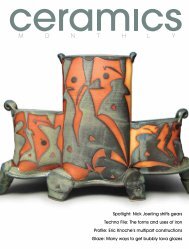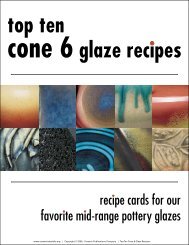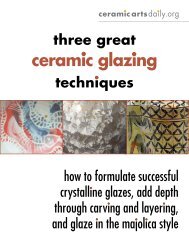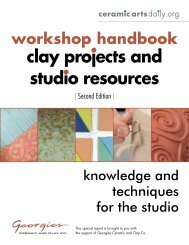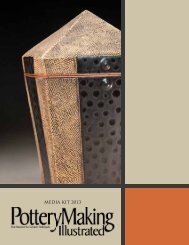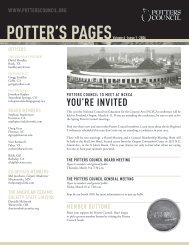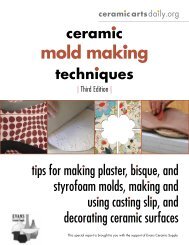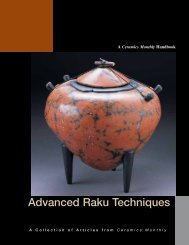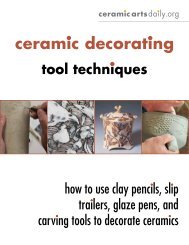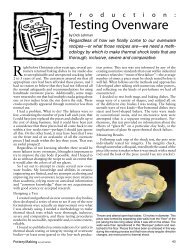Surface, Glaze Form - Ceramic Arts Daily
Surface, Glaze Form - Ceramic Arts Daily
Surface, Glaze Form - Ceramic Arts Daily
Create successful ePaper yourself
Turn your PDF publications into a flip-book with our unique Google optimized e-Paper software.
<strong>Surface</strong>,<br />
& <strong>Glaze</strong> <strong>Form</strong><br />
Edited by Anderson Turner<br />
Pottery<br />
Techniques<br />
<strong>Ceramic</strong><br />
<strong>Arts</strong><br />
Handbook<br />
Series
<strong>Surface</strong>,<br />
& <strong>Glaze</strong> <strong>Form</strong><br />
i
Edited by Anderson Turner<br />
The American <strong>Ceramic</strong> Society<br />
600 N. Cleveland Ave., Suite 210<br />
Westerville, Ohio 43082<br />
www.<strong>Ceramic</strong><strong>Arts</strong><strong>Daily</strong>.org<br />
<strong>Surface</strong>,<br />
& <strong>Glaze</strong> <strong>Form</strong><br />
Pottery<br />
Techniques<br />
<strong>Ceramic</strong><br />
<strong>Arts</strong><br />
Handbook<br />
Series
<strong>Ceramic</strong> <strong>Arts</strong> Handbook<br />
iv<br />
The American <strong>Ceramic</strong> Society<br />
600 N. Cleveland Ave., Suite 210<br />
Westerville, OH 43082<br />
© 2012 by The American <strong>Ceramic</strong> Society, All rights reserved.<br />
ISBN: 978-1-57498-325-8 (Paperback)<br />
ISBN: 978-1-57498-566-5 (PDF)<br />
No part of this book may be reproduced, stored in a retrieval system or transmitted<br />
in any form or by any means, electronic, mechanical, photocopying, microfilming,<br />
recording or otherwise, without written permission from the publisher, except by a<br />
reviewer, who may quote brief passages in review.<br />
Authorization to photocopy for internal or personal use beyond the limits of Sections<br />
107 and 108 of the U.S. Copyright Law is granted by The American <strong>Ceramic</strong> Society,<br />
provided that the appropriate fee is paid directly to the Copyright Clearance Center,<br />
Inc., 222 Rosewood Drive, Danvers, MA 01923 U.S.A., www.copyright.com. Prior<br />
to photocopying items for educational classroom use, please contact Copyright<br />
Clearance Center, Inc. This consent does not extend to copyright items for general<br />
distribution or for advertising or promotional purposes or to republishing items<br />
in whole or in part in any work in any format. Requests for special photocopying<br />
permission and reprint requests should be directed to Director, Publications, The<br />
American <strong>Ceramic</strong> Society, 600 N. Cleveland Ave., Westerville, Ohio 43082 USA.<br />
Every effort has been made to ensure that all the information in this book is accurate.<br />
Due to differing conditions, equipment, tools, and individual skills, the publisher<br />
cannot be responsible for any injuries, losses, and other damages that may result<br />
from the use of the information in this book. Final determination of the suitability of<br />
any information, procedure or product for use contemplated by any user, and the<br />
manner of that use, is the sole responsibility of the user. This book is intended for<br />
informational purposes only.<br />
The views, opinions and findings contained in this book are those of the author. The<br />
publishers, editors, reviewers and author assume no responsibility or liability for<br />
errors or any consequences arising from the use of the information contained herein.<br />
Registered names and trademarks, etc., used in this publication, even without specific<br />
indication thereof, are not to be considered unprotected by the law. Mention of trade<br />
names of commercial products does not constitute endorsement or recommendation<br />
for use by the publishers, editors or authors.<br />
Publisher: Charles Spahr, Executive Director, The American <strong>Ceramic</strong> Society<br />
Art Book Program Manager: Bill Jones<br />
Series Editor: Anderson Turner<br />
Ebook Manager: Steve Hecker<br />
Graphic Design and Production: Melissa Bury, Bury Design, Westerville, Ohio<br />
Cover Images: Gilded Pasture by Steven Young Lee; (top right) Swirls and Stripes by<br />
Jason Bige Burnett; (bottom right) platter by Tim Ludwig (photo by Randall Smith).<br />
Frontispiece: Vase by John Britt
Contents<br />
When the Negative is Positive 1<br />
Ursula Hargens<br />
Pour It On 6<br />
Sam Scott<br />
Sarah Jaeger: Joyful Pots 11<br />
Emily Donahoe<br />
Less is More 16<br />
Courtney Murphy<br />
Second Childhood 21<br />
Linda Gates<br />
Playing Dress-Up 26<br />
Magda Glusek<br />
Slip Transfer 33<br />
Jason Bige Burnett<br />
Slip and Sgraffito 38<br />
Kristin Pavelka<br />
Layering Slips, <strong>Glaze</strong>s and Decals 43<br />
Andrew Gilliatt<br />
Elevating Earthenware 49<br />
Ben Carter<br />
Forrest Lesch-Middelton: Layer by Layer 53<br />
Jeffrey Spahn<br />
Paul Barchilon: Arabesque Designs 57<br />
Annie Chrietzberg<br />
Designing for Food 61<br />
Gwendolyn Yoppolo<br />
Making Bisque Molds 67<br />
Nancy Zoller
Marcos Lewis: Urchin Texure 71<br />
Annie Chrietzberg<br />
Etched in Clay 73<br />
Jim Gottuso<br />
<strong>Glaze</strong> Etching 77<br />
Ann Ruel<br />
A Rainbow Revealed 79<br />
Adrian Sandstrom<br />
Block Printing Stamps 83<br />
Ann Ruel<br />
Grouting for Effect 87<br />
Laura Reutter<br />
Word Decoration 91<br />
Connie Norman<br />
A Painterly Approach 95<br />
Tim Ludwig<br />
Using the Correct Brush 99<br />
Michael Harbridge<br />
Chinese Brush Painting 101<br />
Elizabeth Priddy<br />
Majolica Decoration 107<br />
Jake Allee<br />
Expanding A Mid-Range Palette 111<br />
Yoko Sekino-Bove<br />
Cone Six Celadons 115<br />
John Britt<br />
Bristol <strong>Glaze</strong>s 120<br />
Cheryl Pannabecker<br />
Peach Bloom <strong>Glaze</strong>s 123<br />
John Britt<br />
Steven Young Lee: West to East and Back Again 131<br />
Casey Ruble
Preface<br />
The focus of this book is not just on the surface of the object you make, but also<br />
on the complete design process. Many <strong>Ceramic</strong>s Monthly and Pottery Making<br />
Illustrated articles have been chosen because they cover some part or all of the<br />
aspects of making a piece out of clay. One of my favorite artists whose work has<br />
been included in this book is Gwendolyn Yopollo. The article we have included<br />
details her consideration for the design, form and surface of an Orange Juicer.<br />
It is strong example of how clay artists can speak to formal aesthetic considerations<br />
while creating a utilitarian piece. It’s also just a solid example of great<br />
ideas and great work. I hope it inspires you too.<br />
This book marks the end of the <strong>Ceramic</strong> <strong>Arts</strong> Handbook series of twelve<br />
books and it felt right to have a broad approach to selecting articles for inclusion.<br />
As artists who focus on clay, we are not asked to do just one thing. We are<br />
walking and talking one-person companies in charge of developing our products,<br />
marketing and customer service. It has been the intention of this series<br />
of books to feed the soul of the artist. To give insights, but mostly to inspire<br />
your thought process in a new direction that will help you develop your ideas<br />
and keep you working. I like to imagine you taking one of these books into the<br />
studio, breaking the spine and using it as a resource for a project you are working<br />
on. I hope you have enjoyed these books as much as I have enjoyed helping<br />
to bring them to you.<br />
Anderson Turner<br />
<strong>Surface</strong><br />
<strong>Glaze</strong>&<strong>Form</strong><br />
vii
When the<br />
Negative Is Positive<br />
by Ursula Hargens<br />
As the decoration on my<br />
thrown work has become<br />
more detailed and elaborate,<br />
I’ve begun looking to extend my decoration<br />
over larger surfaces. I chose<br />
wall tiles as a way to create largescale<br />
compositions, treating the ceramic<br />
surface as a single canvas.<br />
In designing my tiles, I set out to<br />
create standardized units that could<br />
be configured in multiple ways. My<br />
goal was to make tiles that were<br />
manageable but could be combined<br />
to create larger compositions. Altering<br />
the shape of a traditional square<br />
tile by manipulating the silhouette<br />
allowed me to create patterns with<br />
the tile forms themselves. I could<br />
use the same molds to make different<br />
shaped surfaces, giving me the<br />
ability to modify the overall size or<br />
orientation of a piece.<br />
In my Wallflower series, I use two<br />
tile molds to create arrangements<br />
that reflect different compositional<br />
approaches—a repeating pattern<br />
and a single decorative pattern that<br />
spans the surface of the tiles. The<br />
cutouts in the tile provide an added<br />
challenge, requiring the surface<br />
decoration to respond to the empty<br />
spaces, corners, and edges created<br />
by the irregular shapes.<br />
Making the Template and Mold<br />
To make the tile mold, begin by cutting<br />
a positive model out of medium<br />
density fiberboard (MDF) using a table<br />
saw and jigsaw. Sand the model<br />
to create a slight angle so you can<br />
remove it after the plaster sets up,<br />
and apply several coats of polyurethane<br />
to seal it. Make a tile press<br />
mold by setting up wooden cottles in<br />
<strong>Surface</strong><br />
<strong>Glaze</strong>&<strong>Form</strong><br />
Wallflower<br />
(Reflection), 56 in.<br />
(1.4 m) in height,<br />
earthenware, glaze,<br />
fired to cone 05, gold<br />
luster, fired to cone<br />
018. Photo by Peter<br />
Lee.<br />
1
<strong>Ceramic</strong> <strong>Arts</strong> Handbook<br />
2<br />
1 2<br />
MDF positive next to the finished plaster press mold. Use a tarpaper template to cut a slab for the mold.<br />
3<br />
Add clay strips for the sides and reinforce with coils. Apply one or more coats of white slip.<br />
a square, clamping them, and filling<br />
the seams with clay coils. The cottles<br />
should be at least one inch from<br />
the edges of the MDF model. Then,<br />
secure the model so it won’t move<br />
when the plaster is poured around it,<br />
coat it and the surrounding surfaces<br />
with Murphy’s Oil Soap, and pour in<br />
enough plaster to cover the mold by<br />
at least one inch. After the plaster<br />
sets, remove the cottles, clean up the<br />
edges of the mold with a rasp, and<br />
dry it for several days (figure 1).<br />
Pressing a Tile<br />
4<br />
To make a tile, roll a slab of clay<br />
½-inch thick, and cut it in the shape<br />
of your tile. Use the MDF model as<br />
a guide or make a flexible template<br />
from cardboard or tarpaper (figure<br />
2). Gently lay the slab into the mold<br />
and press the clay down, paying attention<br />
to the corners and edges as<br />
those are the areas often missed.<br />
Next, cut strips of clay to press into<br />
the sides of the mold and reinforce<br />
the seams with coils (figure 3).<br />
Cover the tile with plastic and<br />
leave it overnight so that it sets up<br />
to leather hard. The next day, place<br />
a board across the mold opening and<br />
flip it over as you would flip a cake,<br />
so that the tile rests on the board.<br />
You may need to tap the mold with<br />
your fist to make the tile pop out.<br />
Clean up any rough edges with a rib.
5 6<br />
Apply colored slip over the clay and paper resist.<br />
Applying Slip<br />
Coat the tile with a first layer of<br />
slip (figure 4). A white slip produces<br />
a light ground and brightens glaze<br />
colors, but any slip color can be used.<br />
Note the consistency of the slip and<br />
the wetness of the brush. If the slip<br />
is thin and applied in quick, single<br />
strokes, it appears translucent in<br />
places with the red clay showing<br />
beneath. If the slip is thicker (like<br />
cream) and applied in multiple<br />
strokes, it creates an opaque, white<br />
surface. You can also affect the way<br />
the slip lays on the surface through<br />
the wetness of the brush; a wet<br />
brush gives you a lighter, more fluid<br />
application and a dry brush pulls on<br />
the surface leaving a denser, slightly<br />
textured slip layer. Allow the slip<br />
to dry until the sheen is gone and it<br />
becomes firm to the touch.<br />
Using Paper Resist<br />
Apply additional layers of slip design.<br />
7 8 9<br />
Poke holes through a paper design. Make a pouncing sack. Pounce the design.<br />
Now apply any secondary slip designs<br />
using paper resist techniques.<br />
I make colored slips by adding 10–<br />
20% stain to a white slip base, but<br />
any commercial underglaze or slip<br />
will work. Draw an image or shape<br />
onto newspaper. If you’re going to<br />
repeat a design, make a master<br />
template out of heavier cardstock<br />
that you can trace if you need additional<br />
shapes. Use several pieces<br />
<strong>Surface</strong><br />
<strong>Glaze</strong>&<strong>Form</strong><br />
3
<strong>Ceramic</strong> <strong>Arts</strong> Handbook<br />
4<br />
10 11 12<br />
Apply a glaze outline. Fill in the outlines.<br />
Pour clear glaze over the surface.<br />
of newspaper so you’re cutting multiple<br />
sheets at once. With scissors or<br />
a matte knife, cut an outline of the<br />
pattern. Keep both the positive and<br />
negative image intact so you have<br />
the option of using both the original<br />
shape and the outline in your design.<br />
Lay the paper cutout on the surface<br />
and spray with a light mist of<br />
water to adhere it. Try not to use too<br />
much water as it can cause the white<br />
slip ground to moisten and smudge.<br />
Using your fingers, press the edge of<br />
the paper to the surface so there are<br />
no buckles or gaps around the edge<br />
of the design for slip to seep underneath.<br />
After all excess water from<br />
spraying has evaporated, apply colored<br />
slip, brushing from the perimeter<br />
inward (figure 5). Once the paper<br />
has been tacked to the surface by the<br />
slip, you can go back over it to create<br />
lines or texture with your brush.<br />
Wait for the slip to lose its sheen,<br />
and use a pin tool to lift up the paper<br />
from the surface, revealing the resist<br />
pattern (figure 6). This process can<br />
be repeated multiple times to extend<br />
a pattern or create a layered surface.<br />
Dry the tiles slowly between layers<br />
of sheetrock (drywall) boards<br />
and put something heavy (the press<br />
mold itself works fine) on top to prevent<br />
warping. I bisque my tiles to<br />
cone 03 in an electric kiln.<br />
Apply a Repeated Pattern<br />
In order to repeat a glaze pattern<br />
multiple times, I use the Renaissance<br />
technique of pouncing. Trace<br />
the outline of the tile and pencil in<br />
a design for that tile shape. Then,<br />
perforate the paper by poking holes<br />
along the lines of the design with a<br />
pin tool (figure 7). This step is tedious,<br />
but once it’s made, your outline<br />
can be used over and over again.<br />
When finished, lay the paper on top<br />
of a bisqued tile and rub a charcoal<br />
stick over the holes. I’ve found I get a<br />
darker outline using a pouncing sack<br />
that I make by pouring powdered<br />
graphite (available at most art supply<br />
stores) onto a small, cloth circle<br />
that is gathered and tied off with a<br />
string or twist tie to create a small<br />
bag (figure 8). Pat the sack over the<br />
pin-pricked design to release the
powder through the holes (figure 9).<br />
Once the pattern is pounced on<br />
the tile, trace the outline with a pencil<br />
to connect the dots and secure the<br />
pattern since the tile is often heavily<br />
handled in the glazing process and<br />
the pounced pattern can be easily<br />
blown away.<br />
Applying <strong>Glaze</strong><br />
The first step to glazing is outlining<br />
the pattern. I use a black glaze that<br />
I mix in small batches at a thicker<br />
than normal consistency. You can<br />
also let a glaze stand for a few days<br />
with its lid off to thicken it through<br />
evaporation. The glaze is then put<br />
into squeeze bottles with needle tips<br />
and applied as a drawn line. You<br />
can buy squeeze bottles at ceramic<br />
supply stores or make your own (see<br />
box). I recommend using a 16 or 18<br />
gauge nozzle.<br />
The glaze line produced from the<br />
applicator creates a raised line,<br />
making a little wall of glaze (figure<br />
10). The second step in glazing is to<br />
fill in the walled-off areas with colored<br />
glazes (figure 11). The glazes<br />
for this step should be a cream-like<br />
consistency so they flow into the<br />
walled-in reservoir and create an<br />
evenly glazed surface. If the glaze<br />
accidentally extends outside the desired<br />
area, it can be scraped off with<br />
a pin tool or small knife when dry.<br />
Once all the areas are filled in<br />
with glaze and the surface is dry to<br />
the touch, brush liquid wax resist<br />
over the glazed areas. This keeps<br />
the glazes true to their original color<br />
and texture after the next step and<br />
prevents the design from running<br />
and blurring. After applying the wax,<br />
allow the pieces to stand overnight<br />
so that the wax resist dries fully and<br />
there’s less clean-up.<br />
The final glazing step is to dip,<br />
pour, or brush clear glaze over the<br />
surface (figure 12). This fills in background<br />
areas not covered by the<br />
colored glazes. I mix this glaze to a<br />
skim-milk consistency so it repels<br />
easily from the waxed areas. If it<br />
does cling to the waxed parts, remove<br />
it by dabbing with a damp sponge.<br />
Firing and Hanging<br />
After glazing, fire to cone 05 in an<br />
electric kiln. I bisque higher than I<br />
glaze fire to minimize pinholing and<br />
other glaze defects. After this firing, I<br />
frequently apply gold luster in small<br />
areas and re-fire the tile to cone 018.<br />
Homemade <strong>Glaze</strong> Trailer<br />
I use a homemade tool created from a nasal<br />
aspirator used for infants, a ball inflating<br />
needle, and a piece of masking tape.<br />
Clip off the end (approximately ½ inch)<br />
of the nasal aspirator so that you can just<br />
squeeze the inflating needle snugly in the<br />
opening. Inflating needles have a second<br />
small hole on the side; a small piece of<br />
masking tape wrapped around the end of<br />
the needle adequately blocks this hole. I<br />
like these homemade applicators because<br />
they are inexpensive, it is easy to replace<br />
the needle if it gets clogged, and I prefer<br />
the way the bulb feels—as if it’s an extension<br />
of my hand.<br />
<strong>Surface</strong><br />
<strong>Glaze</strong>&<strong>Form</strong><br />
5



